The AMD Threadripper 2990WX 32-Core and 2950X 16-Core Review
by Dr. Ian Cutress on August 13, 2018 9:00 AM ESTHEDT Benchmarks: Encoding Tests
With the rise of streaming, vlogs, and video content as a whole, encoding and transcoding tests are becoming ever more important. Not only are more home users and gamers needing to convert video files into something more manageable, for streaming or archival purposes, but the servers that manage the output also manage around data and log files with compression and decompression. Our encoding tasks are focused around these important scenarios, with input from the community for the best implementation of real-world testing.
Handbrake 1.1.0: Streaming and Archival Video Transcoding
A popular open source tool, Handbrake is the anything-to-anything video conversion software that a number of people use as a reference point. The danger is always on version numbers and optimization, for example the latest versions of the software can take advantage of AVX-512 and OpenCL to accelerate certain types of transcoding and algorithms. The version we use here is a pure CPU play, with common transcoding variations.
We have split Handbrake up into several tests, using a Logitech C920 1080p60 native webcam recording (essentially a streamer recording), and convert them into two types of streaming formats and one for archival. The output settings used are:
- 720p60 at 6000 kbps constant bit rate, fast setting, high profile
- 1080p60 at 3500 kbps constant bit rate, faster setting, main profile
- 1080p60 HEVC at 3500 kbps variable bit rate, fast setting, main profile
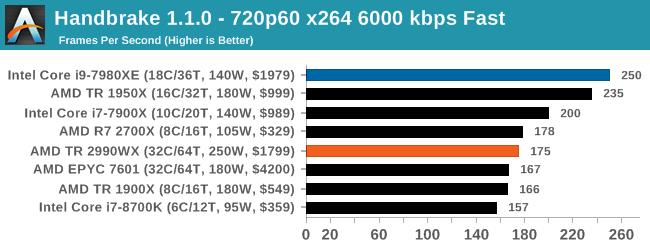
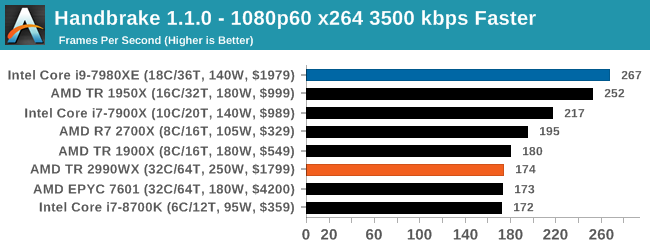
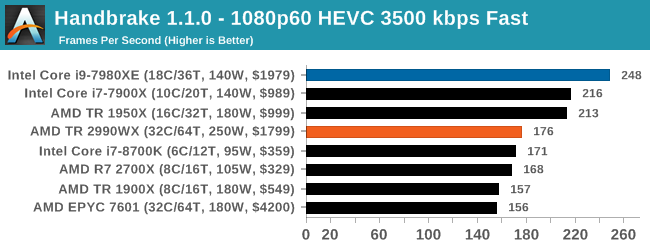
Video encoding is always an interesting mix of multi-threading, memory latency, and compute. The Core i9, with AVX2 instructions, sets a commanding lead in all three tests. The AMD processors seem to fluctuate a bit, with the 1950X and 2700X being the best of the bunch. Unfortunately we didn’t get 2950X results in our initial runs, but I would expect it to be competitive with the Core i9 for sure, given where the 1950X is. However the 2990WX does fall behind a bit.
7-zip v1805: Popular Open-Source Encoding Engine
Out of our compression/decompression tool tests, 7-zip is the most requested and comes with a built-in benchmark. For our test suite, we’ve pulled the latest version of the software and we run the benchmark from the command line, reporting the compression, decompression, and a combined score.
It is noted in this benchmark that the latest multi-die processors have very bi-modal performance between compression and decompression, performing well in one and badly in the other. There are also discussions around how the Windows Scheduler is implementing every thread. As we get more results, it will be interesting to see how this plays out.
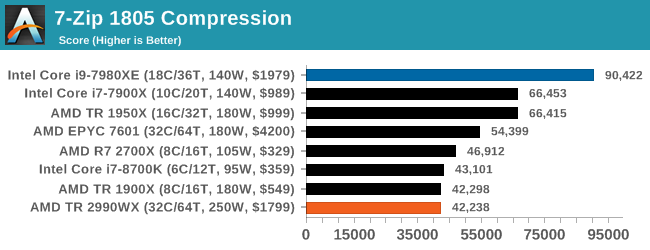
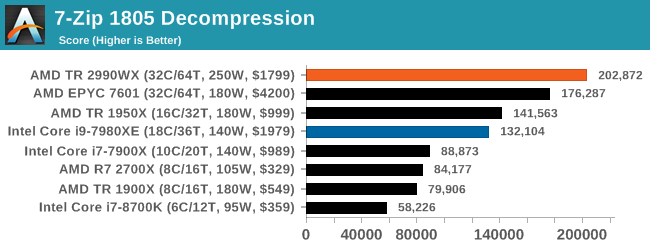
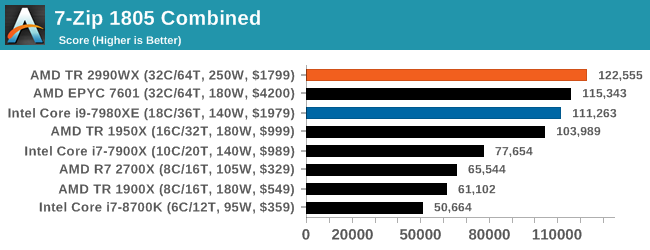
Oh boy, this was an interesting set of tests. When we initially published this review, without commentary, the compression graph with the 2990WX at the bottom was shared around social media like crazy, trying to paint a picture of why AMD performance isn’t great. It was also used in conjuction with Phoronix’s tests, that showed a much better picture on Linux.
But what confuses me is that almost no-one also posted the decompression graph. Here AMD’s 32-core processors take a commanding lead, with the 16/18-core parts being the best of the rest.
If you plan to share out the Compression graph, please include the Decompression one. Otherwise you’re only presenting half a picture.
WinRAR 5.60b3: Archiving Tool
My compression tool of choice is often WinRAR, having been one of the first tools a number of my generation used over two decades ago. The interface has not changed much, although the integration with Windows right click commands is always a plus. It has no in-built test, so we run a compression over a set directory containing over thirty 60-second video files and 2000 small web-based files at a normal compression rate.
WinRAR is variable threaded but also susceptible to caching, so in our test we run it 10 times and take the average of the last five, leaving the test purely for raw CPU compute performance.

A set of high frequency cores and good memory is usually beneficial, but sometimes some more memory bandwidth and lower latency helps. At the top is AMD’s R7 2700X, with the Intel 10-core just behind. I’m surprised not to see the 8700K in there, perhaps its six cores is not enough. But the higher core count AMD parts struggle to gain traction here, with the 32-core parts taking some sweet time to finish this test.
AES Encryption: File Security
A number of platforms, particularly mobile devices, are now offering encryption by default with file systems in order to protect the contents. Windows based devices have these options as well, often applied by BitLocker or third-party software. In our AES encryption test, we used the discontinued TrueCrypt for its built-in benchmark, which tests several encryption algorithms directly in memory.
The data we take for this test is the combined AES encrypt/decrypt performance, measured in gigabytes per second. The software does use AES commands for processors that offer hardware selection, however not AVX-512.
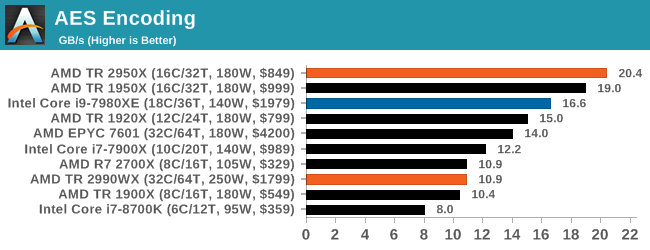
Normally we see this test go very well when there are plenty of cores, but it would seem that the bi-modal nature of the cores and memory controllers in the 2990WX gives a poor result. The EPYC 7601, with eight memory controllers, does a better job, however the 1950X wins here. The 2950X, where all cores have a similar access profile, scores top here, well above Intel’s 18-core Core i9.










171 Comments
View All Comments
edzieba - Monday, August 13, 2018 - link
Not really. In chasing Moar Cores you only excel in embarrassingly parallel workloads. And embarrassingly parallel workloads are in GPGPU's house. And GPU lives in GPGPU's house.boeush - Monday, August 13, 2018 - link
Try to run multiple VMs/Containers and/or multiple desktop sessions on a GPGPU: you might find out that GPGPU's house isn't all it's cracked up to be...SonicKrunch - Monday, August 13, 2018 - link
Look at that power consumption. I'm not suggesting AMD didn't create a really great CPU here, but they really need to work on their efficiency. It's always been their problem, and it's not seemingly going away. The market for these near 2k chips is also not huge in comparison to normal desktop space. Intel has plenty of time to answer here with their known efficiency.The_Assimilator - Monday, August 13, 2018 - link
Yeah... look at the number of cores, numpty.somejerkwad - Monday, August 13, 2018 - link
The same efficiency that has consumer-grade products operating on more electricity in per-core and per-clock comparisons? Overclocking power gets really silly on Intel's high end offerings too, if you care to look at the numbers people are getting with an i9 that has fewer cores.eddman - Monday, August 13, 2018 - link
Interesting, can you post a link, please? I've read a few reviews here and there and when comparing 2600x to 8700k (which is more or less fair), it seems in most cases 8700k consumes less energy, even though it has higher boost clocks.CrazyElf - Monday, August 13, 2018 - link
The 8700k is not the problem. It is Skylake X.https://www.tomshardware.com/reviews/-intel-skylak...
Power consumption when you OC X299 scales up quickly. Threadripper is not an 8700k competitor. It is an X299 competitor. The 32 core AMD is clearly priced to compete against the 7980X, unless Intel cuts the price.
eddman - Tuesday, August 14, 2018 - link
I should've made it clear. I was replying to the "more electricity in per-core and per-clock" part. Also, he wrote consumer-grade, which is not HEDT. I do know that TR competes with SKL-X.Comparing OCing power consumption is rather pointless when one chip is able to clock much higher.
Even when comparing 2950 to 7980, there are a lot of instances where 7980 consumes about the same power or even less. I don't see how ryzen is more efficient.
alpha754293 - Monday, August 13, 2018 - link
@ibnmadhi"It's over, Intel is finished."
Hardly.
For example, the Threadripper 2990WX (32C, 3.0 GHz) gets the highest score in POV-Ray 3.7.1 benchmark, but when you compute the efficiency, it's actually the worst for it.
It consumes more power and only gets about 114 points per (base clock * # of cores - which is a way to roughly estimate the CPU's total processing capability).
By comparison, the Intel Core i9-7980XE (18C, 2.6 GHz) is actually the MOST EFFICIENT at 168 points per (base clock * # of cores). It consumes less power than the Threadripper processors, but it does also cost more.
If I can get a system that can do as much or more for less, both in terms of capital cost and running cost (i.e. total cost of ownership), then why would I want to go AMD?
I use to run all AMD when it was a better value proposition and when Intel's power profile was much worse than AMD's. Now, it has completely flipped around.
Keep also in mind, that they kept the Epyc 7601 processor in here for comparison, a processor that costs $4200 each.
At that price, I know that I can get an Intel Xeon processor, with about the same core count and base clock speed for about the same price, but I also know that it will outperform the Epyc 7601 as well when you look at the data.
As of August, 2018, Intel has a commanding 79.4% market share compared to AMD's 20.6%. That's FARRR from Intel being over.
ender8282 - Monday, August 13, 2018 - link
base clock * number of cores seems like a poor stand in for performance per watt. If we assume that IPC and other factors like mem/cache latency are the same then sure base clock * num cores effectively gives us performance unit of power but we know those are not constant.